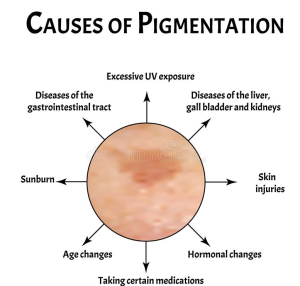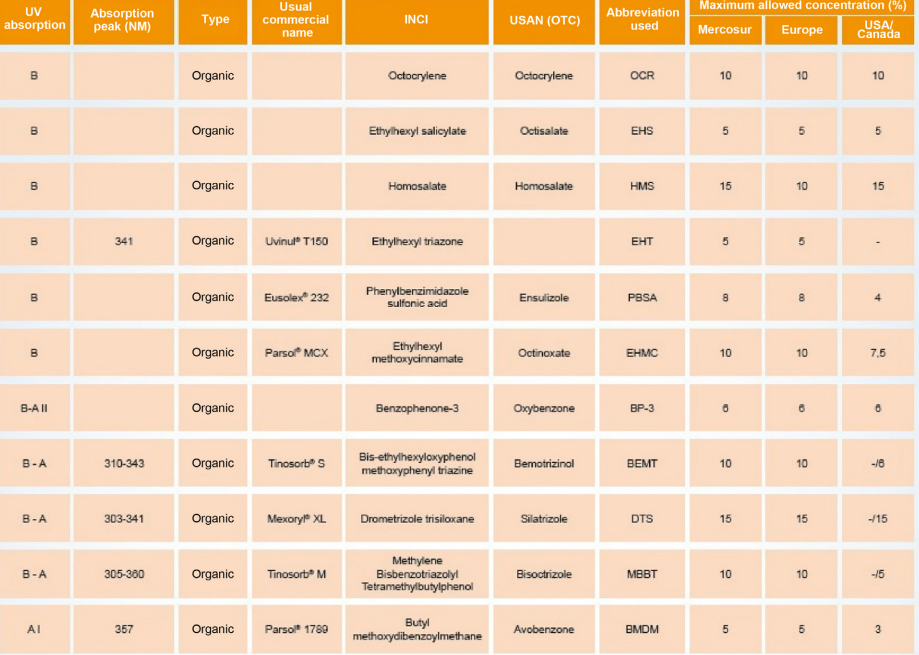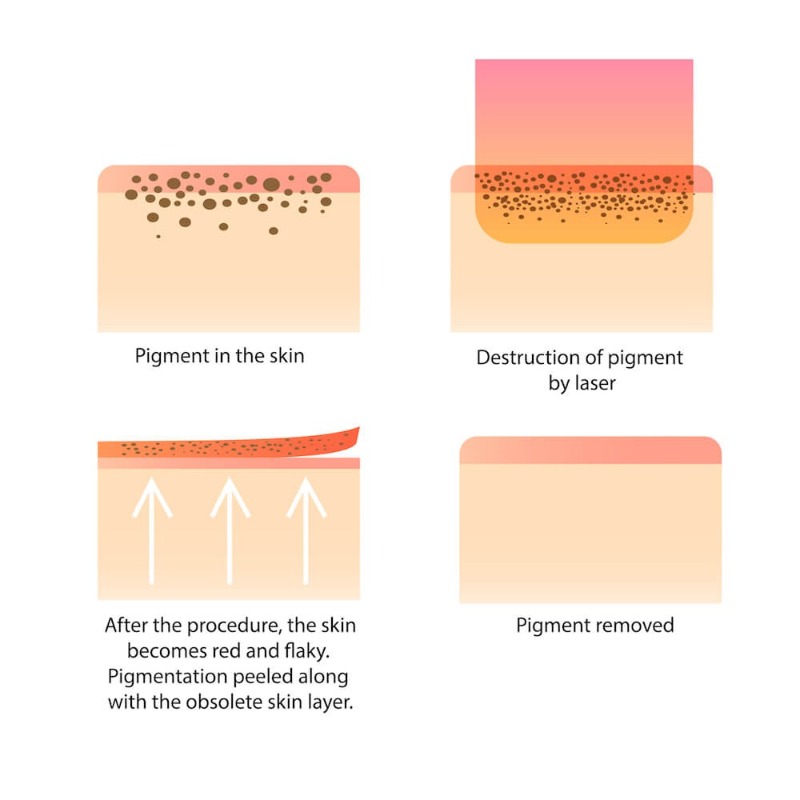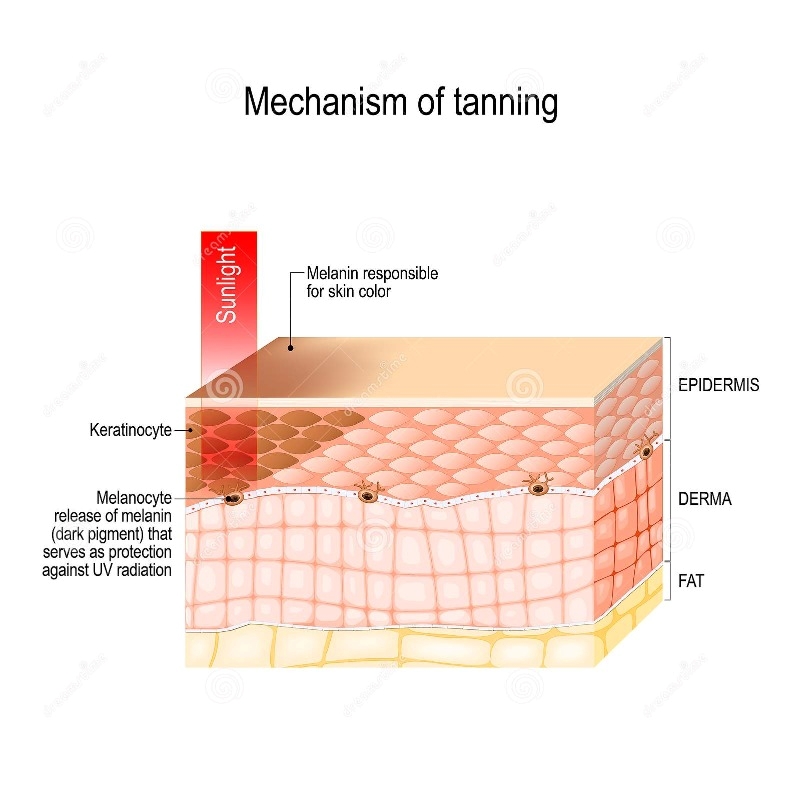Most people search for the term “What is pigmentation on face?”.
Pigmentation is a general term that refers to any coloring of skin or hair, whether it’s lighter or darker. Hyperpigmentation is a darker discoloration in comparison to the surrounding skin. Tanning or sunburn is a type of hyperpigmentation.
The human race exists in a broad range of colors, from light brown to black. A history of the science of pigmentation reviewed by Sydney N. Claus mentions that the seat of skin color has been the subject of research since the sixteenth century among anatomists and physicists. The first modern research on skin color began in 1840 when the population of dendritic cells derived from the neural crest was identified as the source of coloring matter for the skin and hair.
The discoloration of the face on exposure to harmful UV rays lowers one’s self-esteem and sometimes causes embarrassment and lack of confidence in people.
This article will discuss pigmentation on face, what causes pigmentation, and how pigmentation disorders change skin color. What are the natural ways to prevent disordered pigmentation on the face and the face pigmentation laser treatment?
Historical theories on color differences
The most visible indication of racial identity, skin color, was pushed into the focus of the controversy over human unity. For Africans, the variation in skin color gave rise to a plethora of myths and fanciful stories. Europeans believed that blackness in skin was due to long sitting in intense sunlight and heat or to Noha’s curse on Ham and his progeny, mentioned in a well-known passage in Genesis.
Many social issues, such as slavery and the place of “people of color” in the human race, were later settled by the end of the nineteenth century, when skin color scientists became part of a sarcastic topic.
In 1973, researchers proved the scientific reason behind the skin’s color was the pigment cells present in the basal layer of the epidermis. The basal layer cells contain melanocytes that produce a chemical inert and stable pigment named melanin that is displayed as a pattern on the surface of the skin.
What is pigmentation?
What is Pigmentation on the Face?
Pigmentation is the color of skin that you are born with, depending on the physiological structure of your body, which means 100% of it is heritable. Through 7 years of research by the Broad Institute, MIT, and Harvard, researchers discovered that the genetic diversity of pigmentation differs with latitude by researching an African group that is overlooked in most data statistics.
What Causes Pigmentation?
What Causes Pigmentation on the Face and Body?
As shown in the diagram below, discoloration of skin pigmentation on the face or other parts of the body is caused by sun exposure, inflammation such as acne, hormonal imbalances, pregnancy, and other factors. The major reasons are sun exposure, inflammation such as acne, hormonal imbalances, and pregnancy. Pigmentation occurs on the outer layer of the skin, the epidermis, which is above all three layers of skin. Skin tanning occurs on exposure to sunlight when the epidermis comes into contact with UV rays.

Reasons for Hyperpigmentation
The melanin responsible for pigmentation protects the body against environmental factors and harmful UV rays. Skin is the largest immune organ that interacts with the environment by acting as a physical barrier against mechanical, physical, and chemical factors like water loss and bacteria that may affect the physiological grade of the body. It regenerates and stores fat and water.
The Reason for Face Pigmentation
The Reason for Face hyperpigmentation
Let’s see how the process of face pigmentation on exposure to sunlight triggers the production of melanin and how it has been seen that people with high levels of melanin production have a lower risk of skin cancer. As you can see, in the image mentioned below, are the layers of skin in which the epidermis consists of tiny 3 sublayers of skin. Melanosomes are a house for the synthesis of melanin that resides in melanocytes, which are found in hair and skin follicles. Melanosomes are transferred from melanocytes to keratinocytes via their dendrites, where they create the melanin caps that protect the human epidermis from Ultra-Violet damage. The epidermis, dermis, and hypodermis, made up of fatty tissue that connects the dermis to the underlying skeletal components, are the three major layers of the skin.
When the epidermis react to the sun’s ultraviolet (UV) radiation, the skin develops a tan, which is the reason for face pigmentation disorder. Your skin sends a message to your melanocytes that says, “Hey, Help me! Melanocytes then produce more melanin, which protects the skin from the sun’s harmful rays.
Unfortunately, the body’s defensive mechanisms are inadequate to totally avoid damage and disorder from the sun’s powerful rays This is due to an increase in reactive oxygen species, which causes DNA damage and the activation of melanogenesis-related enzymes such tyrosinase. Further exposure to UVB rays causes the DNA to be destroyed, resulting in sunburn, also known as apoptosis. Another most researched reason for face hyperpigmentation is Vitamin B12 deficiency.
Several studies have been conducted in relation to the deficiency of Vitamin B12 for skin pigmentation which could one of another major reason for skin pigmentation. Vitamin E, C, and B12 are major vitamins for lightening hyperpigmentation spots. But vitamin B12 supports the growth of new skin cells. It is largely found in meat, fish, eggs, and dairy products. Many rare conditions of hyperpigmentation have been seen related to vitamin B12 deficiency in the form of patches on hands and discolored tongue. A girl with hyperpigmentation on her tongue, face, and palms was treated with injectable cyanocobalamin (Vitamin B12)along with vitamin C, and her appetite improved, glossitis improved, along with gradual fading of pigmentation.

How to prevent pigmentation from face
To prevent dark pigmented patches and spots, there are certain points that need to be considered:
- Avoid direct sunlight and try to avoid going out in sunlight during the peak hours of the day from 10 a.m. to 3 p.m.
- Try to wear a hat and sunglasses to avoid discoloration of the face and eyes.
- Apply minimum of SPF 30 sunscreen to prevent discoloration of the skin.
- Increase your intake of vitamin C in your daily diet.
- Avoid touching your skin.
In addition to the above preventive measures to avoid hyperpigmentation, these are the most effective natural remedies for face pigmentation that you can use daily to avoid face pigmentation.
Face hyperpigmentation can be treated at home using natural products readily available at home.
- Licorice water
Active components in licorice extract have been demonstrated to reduce hyperpigmentation resulting from melasma and sun exposure. . Licorice powder can be easily available in grocery stores or on online shopping portals like www.amazon.com , flipkart.com.
- Tomato Paste
In 2011, the British Journal of Dermatology discovered that lycopene-rich tomato paste protected the skin from both short-term and long-term UV damage. For 12 weeks, participants consumed 55 grams of tomato paste in olive oil. It has been observed that applying tomato paste mixed with gram flour on the face gives mind-blowing results in reducing discolored pigmentation on the face.
- Milk
Lactic acid in sour buttermilk and raw milk has been found to reduce the dark patches on skin when applied daily using a cotton ball.
- Vinegar-water solution
Equal parts of vinegar and water when applied twice a day have been shown to lighten the hyperpigmentation on the face. All you need to do is to apply the solution for two to three minutes and wash it off with lukewarm water.
People generally ask, can sunscreen remove pigmentation? The answer to the question is that sunscreen cannot alone remove hyperpigmentation on its own, but when combined with other treatments, it can reduce and remove hyperpigmentation.
But it has been investigated by researchers that regular use of good quality sunscreen can reduce the signs of invariable photoprotection, wrinkles and erythema (redness of skin in patches).
Sunscreens are formulated on the basis of the SPF factor, which means sun protection factor, i.e., protection against the UVB wavelength of sunlight. The effectiveness of sunscreen depends on many factors, like exposure time, environmental pollutants, and SPF value.
Many questions are raised based on the ingredients used in two forms: organic (chemical) and inorganic (physical or mineral). The UV filters in sunscreen should be friendly to the environment.
According to the latest research published in 2021, International women of dermatology shared the list of sunscreens that are suggested and approved by board certified dermatologists in Brazil, the U.S., Canada, and Europe.

list of approved sunscreens in Canada, Europe, the U.S. and Brazil
Face pigmentation laser treatment
Laser peel, also called skin resurfacing, is a laser treatment that uses focused beams of light to reduce hyperpigmentation. Face pigmentation laser treatment is further divided into two categories: ablative and non-ablative. An ablative laser removes the top layer of skin and makes it stronger. Non-ablative techniques, on the other hand, focus on the epidermis to encourage collagen production and tightening. Skin ablative laser resurfacing treatment is more viable for fair skinned people.
Another highly recommended laser treatment is the ILP laser, also known as non-ablative fractional skin treatment. This photo facial treatment promotes collagen growth in the skin. It takes multiple sessions, depending on the degree of discoloration on the face.
Non-ablative sometimes turns skin darker rather than lightening it. So, it is important to seek advice from your dermatologist’s advice and decide on the best treatment based on your skin tone. Below is a picture showing how the laser removes hyperpigmentation on the skin.

Face pigmentation laser treatment procedure
The fear of hyperpigmentation after laser treatments still occupies my mind with questions like: Does pigmentation come back after laser treatment? If your exposure to sunlight continues, the answer is yes. You may have to take more laser sessions for treatment of patches that have formed. Conditions like melasma return after 3 months of treatment on the discontinuation of follow-up treatments.
Conclusion
The face is a reflection of one’s personality. Longer exposure to sunlight can cause hyperpigmentation on the face, which can cause distress and low self-confidence in many people. Everyone should adopt a personal skin care routine in order to look beautiful and protect their skin tone from environmental damage.
Glutathione is one such element our body processes, but the huge demand for skin whitening has led to the introduction of chemical glutathione in the form of tablets with no authentic information about the dosages in the market.
Sources
- A History of the science of Pigmentation Sydney N. Klaus.
- https://www.sciencedaily.com/releases/2017/12/171201104058.htm
- Hyperpigmentation with Vitamin B12 Deficiency in an Adolescent Girl SH HASANa, R SAMADb, JC DASc, F ARAd, MA FAISAL
- Journal of Bangladesh College of Physicians and SurgeonsVol. 39, No. 1, January 2021.
- https://www.healthline.com/health/home-remedies-for-pigmentation#homeremedies.




Top site ,.. amazaing post ! Just keep the work on !
thank you Gal
I always spent my half an hour to read this web site’s posts everyday along with a cup of coffee.